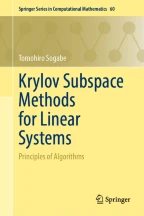
Numerical methods for solving linear systems are classified into two groups: direct methods and iterative methods. Direct methods solve linear systems within a finite number of arithmetic operations, and the best-known direct method is the LU decomposition. Iterative methods produce a sequence of approximate solutions, and the iterative methods are roughly classified into stationary iterative methods and Krylov subspace methods. Multigrid methods also fall into an important class of iterative methods. This chapter aims to describe the principles of the direct methods, the stationary iterative methods, and a brief introduction to the theory of Krylov subspace methods. A brief explanation of multigrid methods is also given.
This is a preview of subscription content, log in via an institution to check access.
eBook EUR 106.99 Price includes VAT (France)
Softcover Book EUR 137.14 Price includes VAT (France)
Hardcover Book EUR 137.14 Price includes VAT (France)
Tax calculation will be finalised at checkout
Purchases are for personal use only
In general, given a vector space V, a map \(\Vert \cdot \Vert :\mathbb \rightarrow \mathbb \) is called a norm if the map satisfies (Nv1)–(Nv3) for all \(\boldsymbol, \boldsymbol\in \mathbb , \alpha \in \mathbb \) ( \(\mathbb =\mathbb \) or \(\mathbb \) ).
“ \(\sup \) ” can be replaced with “ \(\max \) ”.A real square matrix Q is called an orthogonal matrix if \(Q^\top Q = I\) , where I is the identity matrix.
Using MATLAB notation, “all the leading principal minors” of A are defined by det(A(1:1,1:1)), det(A(1:2,1:2)), . det(A(1:n,1:n)).
After the proposal of the CG method, Stiefel proposed the Conjugate Residual (CR) method in 1955, and he is also known for the Stiefel manifold that is an extension of the unit circle.
Matrix \(G \in \mathbb